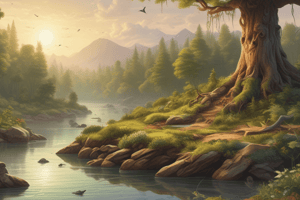Podcast
Questions and Answers
What is the definition of an ecosystem?
What is the definition of an ecosystem?
A system in nature confirmed by weather, climate, rocks, soil, vegetation, and living creatures that interact with each other to maintain equilibrium.
What is the characteristic of the Polar ecosystem?
What is the characteristic of the Polar ecosystem?
Extremely cold temperatures, ice, and snow, with animals and plants adapted to these conditions.
What type of ecosystem has trees that change with the seasons?
What type of ecosystem has trees that change with the seasons?
Deciduous forest
What is the main characteristic of the Desert ecosystem?
What is the main characteristic of the Desert ecosystem?
What is the characteristic of the Tropical Rainforest ecosystem?
What is the characteristic of the Tropical Rainforest ecosystem?
What type of ecosystem is characterized by a mix of different types of trees and many predators?
What type of ecosystem is characterized by a mix of different types of trees and many predators?
What is the main characteristic of the Coral Reef ecosystem?
What is the main characteristic of the Coral Reef ecosystem?
What is the definition of weather?
What is the definition of weather?
What is the main difference between climate and weather?
What is the main difference between climate and weather?
What are air masses, and how do they influence the weather?
What are air masses, and how do they influence the weather?
What is a front, and what are its characteristics?
What is a front, and what are its characteristics?
What is the difference between a cold front and a warm front?
What is the difference between a cold front and a warm front?
What is an occluded front, and how is it formed?
What is an occluded front, and how is it formed?
What is an anticyclone, and how does it affect the weather?
What is an anticyclone, and how does it affect the weather?
What is the main characteristic of a depression, and how does it differ from an anticyclone?
What is the main characteristic of a depression, and how does it differ from an anticyclone?
How does latitude affect the climate of an area?
How does latitude affect the climate of an area?
Study Notes
Ecosystems
- An ecosystem is a system where living creatures, weather, climate, rocks, soil, and vegetation interact to create an equilibrium.
Types of Ecosystems
- Polar ecosystem: found in Arctic and Antarctic regions, characterized by extremely cold temperatures, ice, and snow, with adapted animals and plants.
- Temperate Deciduous Forest: found in North America, Europe, and Asia, characterized by trees that change with the seasons, with leaves falling in autumn.
- Temperate Grassland: found in Hungary, South Africa, and Argentina, characterized by grass covering most of the land, with defined seasons suitable for herbivores and birds.
- Desert: characterized by low precipitation, high temperature, and extreme dryness, with examples including the Sahara Desert and Atacama Desert near the Tropics of Cancer and Capricorn.
- Tropical Rainforest: found near the equator, characterized by a warm and humid climate, with exceptional biodiversity, such as in the Amazonas basin.
- Savanna: found in tropical and subtropical zones, characterized by a mix of different tree types, with many predators, such as herbivores, in places like Africa.
- Coral Reef: found in warm zones with tropical oceans, characterized by massive quantities of corals forming a three-dimensional structure, found between 30° north and 30° south of the equator.
Weather and Climate
- Weather: refers to atmospheric conditions in a specific place and time, including temperature, humidity, and wind speed.
- Climate: refers to atmospheric conditions over a long period, providing a prediction of future weather patterns.
- Difference: weather conditions over a short period, while climate is the average condition over a long period.
Air Masses
- Definition: large bodies of air with uniform temperature, pressure, and humidity that travel long distances, influencing weather.
- 5 types of air masses exist.
Fronts
- Definition: boundary between two different air masses, resulting in turbulent meteorological conditions.
- Types of fronts:
- Cold front: boundary between cold and warm air, where cold air replaces warm air.
- Warm front: boundary between fresh and warm air, where warm air replaces fresh air.
- Occluded front: combination of two fronts, where a cold front overtakes a warm front.
High Pressure and Low Pressure
- Anticyclone (High Pressure): a meteorological system with high pressure, produced when cold air descends to the Earth's surface, resulting in minimal wind and clear skies.
- Depression (Low Pressure): a big area of low pressure with ascending, cooling, and condensing air.
Latitude and Climate
- Sun rays are more concentrated near the equator, resulting in hotter temperatures due to less atmosphere to travel through.
Studying That Suits You
Use AI to generate personalized quizzes and flashcards to suit your learning preferences.
Description
This quiz covers the definition and characteristics of ecosystems, including polar and temperature deciduous forests. Learn about the interactions between living and non-living elements in these ecosystems.




